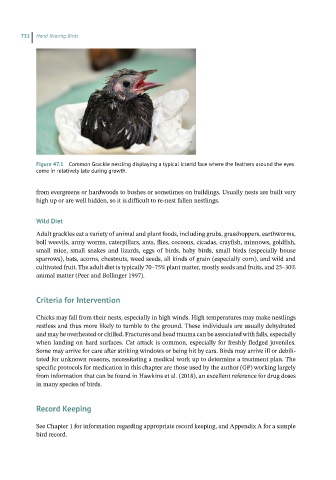Page 730 - Hand rearing birds second
P. 730
732 Hand-Rearing Birds
Figure 47.1 Common Grackle nestling displaying a typical icterid face where the feathers around the eyes
come in relatively late during growth.
from evergreens or hardwoods to bushes or sometimes on buildings. Usually nests are built very
high up or are well hidden, so it is difficult to re‐nest fallen nestlings.
Wild Diet
Adult grackles eat a variety of animal and plant foods, including grubs, grasshoppers, earthworms,
boll weevils, army worms, caterpillars, ants, flies, cocoons, cicadas, crayfish, minnows, goldfish,
small mice, small snakes and lizards, eggs of birds, baby birds, small birds (especially house
sparrows), bats, acorns, chestnuts, weed seeds, all kinds of grain (especially corn), and wild and
cultivated fruit. The adult diet is typically 70–75% plant matter, mostly seeds and fruits, and 25–30%
animal matter (Peer and Bollinger 1997).
Criteria for Intervention
Chicks may fall from their nests, especially in high winds. High temperatures may make nestlings
restless and thus more likely to tumble to the ground. These individuals are usually dehydrated
and may be overheated or chilled. Fractures and head trauma can be associated with falls, especially
when landing on hard surfaces. Cat attack is common, especially for freshly fledged juveniles.
Some may arrive for care after striking windows or being hit by cars. Birds may arrive ill or debili-
tated for unknown reasons, necessitating a medical work up to determine a treatment plan. The
specific protocols for medication in this chapter are those used by the author (GP) working largely
from information that can be found in Hawkins et al. (2018), an excellent reference for drug doses
in many species of birds.
Record Keeping
See Chapter 1 for information regarding appropriate record keeping, and Appendix A for a sample
bird record.

